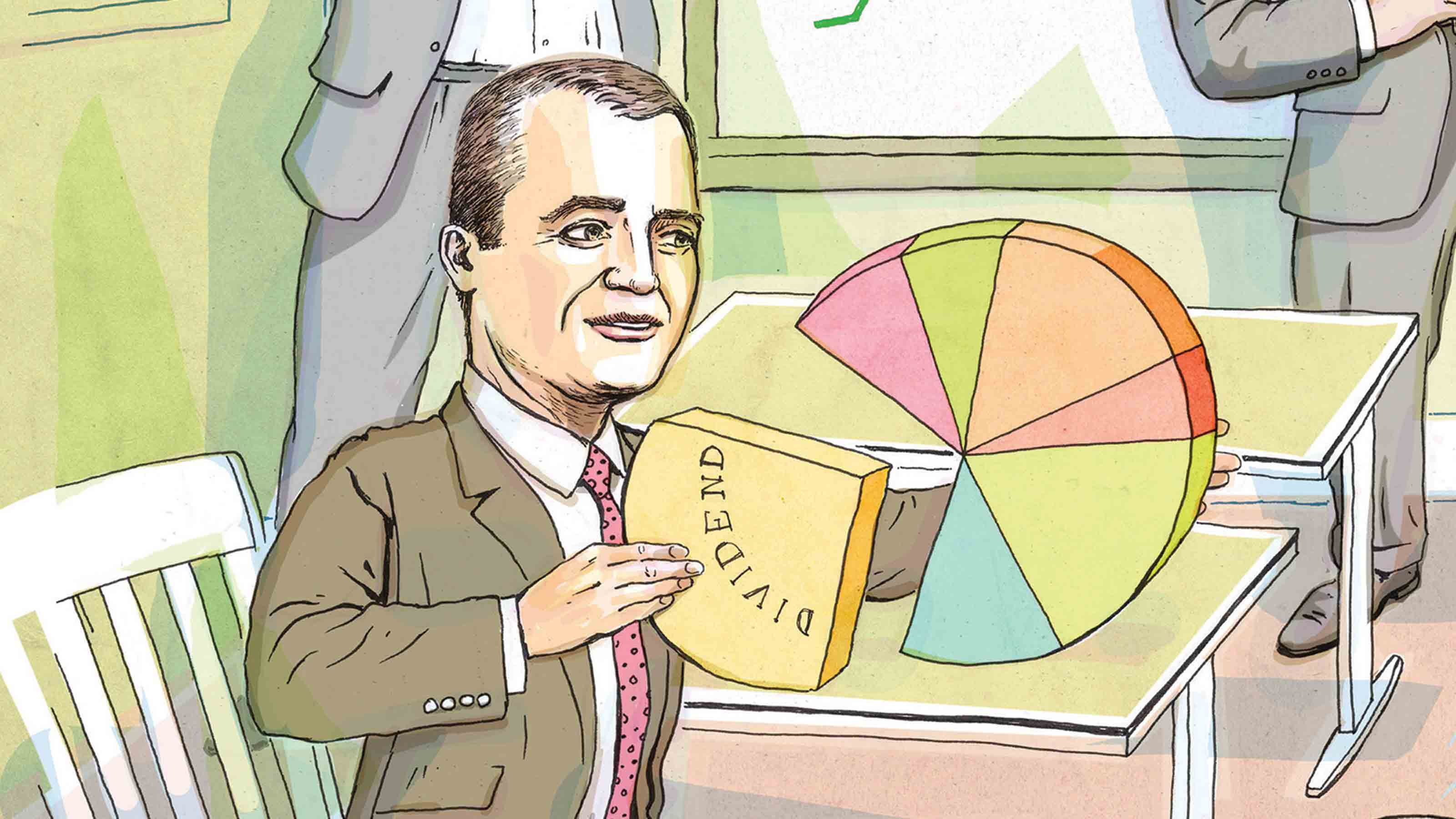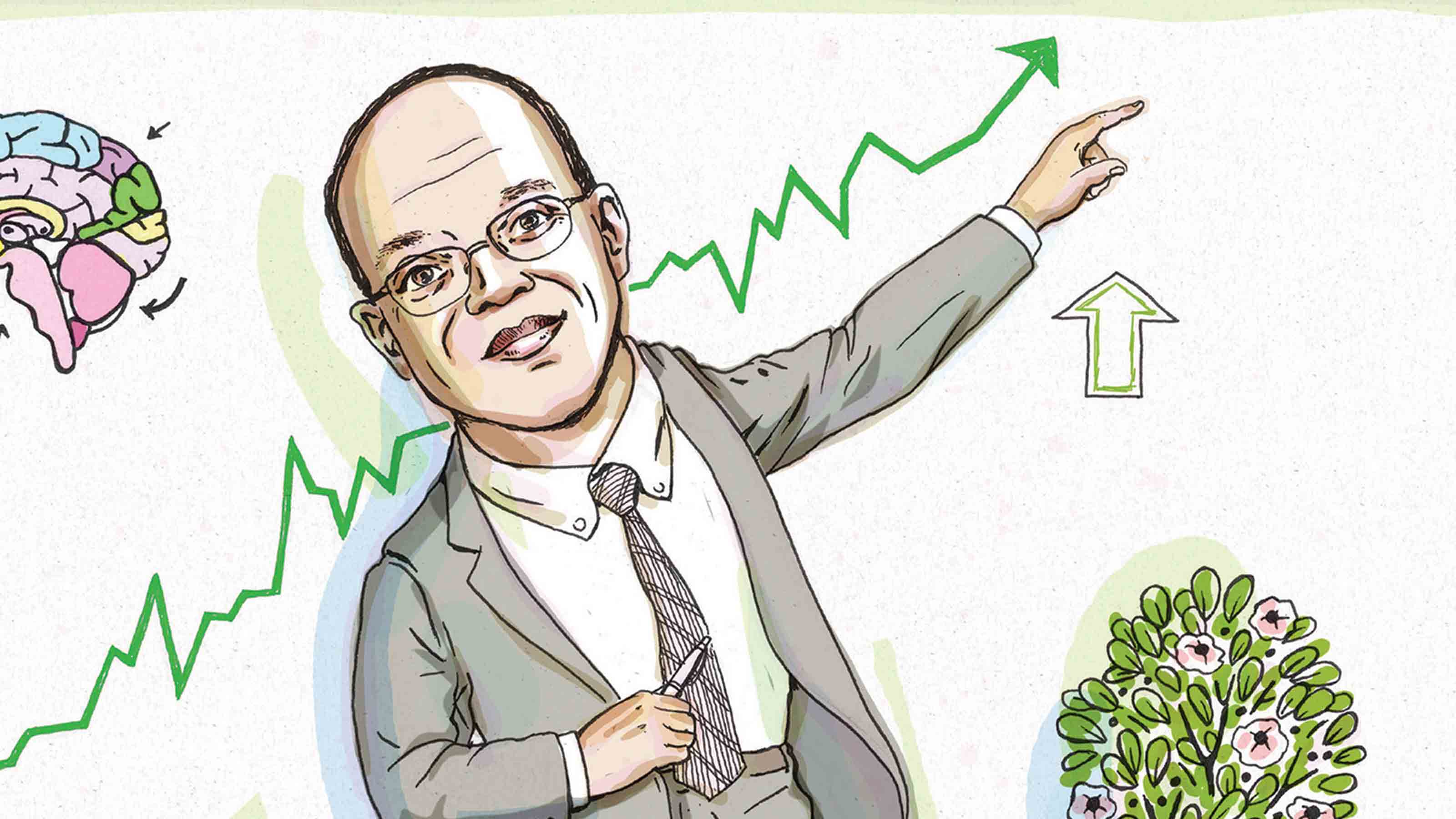Lessons from Top Investing Gurus
Take a master class from some of Wall Street’s best.


Like many investors, you might be managing your nest egg in do-it-yourself mode, despite never studying finance or economics like the Wall Street MBAs and PhDs who construct portfolios for a living. But you don’t have to feel like a C student when it comes to investing or unsure about running your own 401(k). Nearly half (46%) of U.S. adults say they’re “interested in learning more about investing,” according to a survey by AssetMark, a firm that provides technology services to financial advisers.
And what better way to boost your investing IQ than by learning from Wall Street’s best investors? Just as there’s nobody more qualified to teach you about cooking than Gordon Ramsay or how to compose a photo than Annie Leibovitz, a great way to master investing is to pick the brains of the financial gurus who have climbed to the top of the class in the financial world.
So, with markets as unpredictable, volatile and uncertain as ever in the post-pandemic world, we turned to some heavyweights for advice on key personal finance and investment subjects. Topics range from how not to let your emotions sabotage your portfolio to how to avoid buying cheap stocks that are cheap for a reason, and from why it makes sense to buy stocks that rank high on sustainability measures to how you can spot the next big move in the S&P 500 stock index. What follows are mini master classes from some of Wall Street’s best teachers (listed alphabetically), in their own words, designed to help you become an A+ investor.

Katherine Collins
Head of Sustainable Investing, Putnam Investments
A veteran mutual fund manager, Collins is charged with finding companies that make money—and make the world a better place for people and the planet.
The ABCs of ESG investing. Collins: A lot has changed in ESG [environmental, social and governance] investing. The starting point used to be exclusionary: What am I going to cross off my buy list because I don’t want exposure to it? The classic examples are tobacco, defense companies and, more recently, fossil fuels. I favor a different approach. Instead of starting with the question, What are you against? we start with the opposite: What are you for? In other words, where can you find the most-compelling investments where excellence in sustainability is making the company stronger?
There’s a growing recognition that climate change, social equality and human well-being are the issues of our time. Sustainability has gone from being kind of a nice, optional thing to have to being a centerpiece of corporate strategy. Sustainability considerations can and probably should be woven into all investment decisions. If you’re putting blinders on, you’re missing the most important opportunities of our lifetime.
The case for sustainable investing. The ESG stocks we like aren’t just nicer companies, they’re better companies. There are plenty of companies with great ESG bona fides and financial fundamentals that aren’t so great, and vice versa. But when the two coincide, it’s powerful. We look for companies where a focus on sustainability is strengthening long-term potential—for example, by improving growth, keeping customers and employees happy, or mitigating risks.
To find them, we ask open-ended questions: What’s needed for a thriving planet? Thriving people? And a thriving public? Investment themes we focus on include combating chronic disease and supporting mental health, data privacy, renewable energy, and sustainable agriculture, to name a few. Stocks we like include Dexcom, which makes glucose monitoring systems for diabetics; solar panel installer Sunrun; and fast-food chain Chipotle, which employs sustainable farming practices.

David Herro
Manager, Oakmark International
Herro has piloted Oakmark’s flagship international stock fund for nearly 30 years, and his preference for undervalued foreign stocks has proved to be a profitable strategy. In the past year, the fund’s performance has topped 98% of funds in its peer group, and over the past 10- and 15-year periods, it beat 99% of its peers, according to fund tracker Morningstar, which named Herro “International Stock Fund Manager of the Decade” for the 2000–09 period.
The rationale for foreign stocks. Herro: Many investors have a home bias, which is just wanting to invest in your home country. But the U.S. accounts for only about 25% of global economic output. It’s a big world. The number-one reason to invest internationally is to increase the available subset of places to put your money and not limit your opportunities.
The second reason is diversification. Markets around the world don’t move in tandem. And the number-one place where value lives now is in global stock markets. A good example is European banks. France-based BNP Paribas, one of the best banks in Europe, trades at about six to seven times its projected earnings for the next 12 months. Compare that to JPMorgan Chase, one of the best U.S. banks. It trades at 13 times earnings. So, JPMorgan trades at a 100% premium to the best European bank.
Finding hidden gems. Breaking news drives share prices in the short term, but not in the long term. On any given day, a stock can be up or down 5%, and yet the intrinsic value, or what the business is worth, doesn’t change anywhere near that amount. What ultimately drives stock prices is the value created by management when it efficiently converts sales to cash flow that can be used to grow the business. We buy when the stock is selling for less than we think the business is worth. If you’re patient, you can take advantage when the market misprices stocks.
I don’t look at market cycles, election outcomes or interest rates. This information isn’t very useful because you can’t predict what’s going to happen in an election two years out or where rates are headed. People get too caught up in the flavor of the day. A few years back, it was Greece’s debt crisis. Then it was Brexit, and now it’s COVID-19. These stories aren’t useful in valuing businesses. Now, industrial companies in Europe offer good value. The auto sector in Germany is seeing a strong recovery. Yet Daimler, one of Germany’s premium car brands, trades at 7.5 times earnings. That’s a fraction of Tesla’s P/E, and Daimler makes infinitely more money.

Donald Kilbride
Manager, Vanguard Dividend Growth
Known for delivering consistent returns and preserving wealth in down markets, Kilbride focuses on a portfolio of about 40 companies that regularly increase the size of their dividend payouts. The $51.3 billion fund earns a “Gold” rating from Morningstar.
How dividend-growth investing differs. Kilbride: Most people think of dividend investing as equity-income investing—that is to say, you get a predetermined amount in a dividend check every quarter. But dividend-growth investing is different. I’m not interested in the steady number. I want that number—the dividend payout—to grow over time so that I can participate in the growth of the underlying business. With a dividend-growth approach, you benefit from compounding growth over the long term. A stock that yields 14% may seem attractive. But a high yield often is a false positive. What the market is telling you is that there’s a lot of risk, and the company may not be able to maintain the payout.
The winning traits of a dividend-growth stock. The first thing we do is assess a company’s ability to pay and grow a dividend over time. We’re looking for companies that don’t have a lot of debt and fixed costs. Next, we try to ascertain their willingness to pay out a growing dividend. One measure for people to look at is the payout ratio, or the percentage of earnings paid out in dividends each year. A lower payout ratio is better, as it means the company has more capacity to grow its dividend. The payout ratio sweet spot is between 30% and 60%.
Sectors that are big areas for us include companies that sell consumer staples, such as beverages and household products. Industrial companies in aerospace and defense, and health care stocks, are other areas we like. Top holdings that will benefit from the reopening of the economy include medical device maker Medtronic, which has a 10-year dividend growth rate of 11%, and off-price retailer TJX, which owns brands like T.J. Maxx and HomeGoods and has a long-term dividend growth rate of 14%.
The role of dividends in a portfolio. Investing in dividend-growth companies gives you exposure to corners of the market that you might not be getting elsewhere, especially if you’re heavily invested in growth stocks [which are less likely to pay dividends]. Dividend-growth companies have very predictable business models with high, recurring revenues and solid financial positions. These steadier businesses also tend to hold up better in down markets. Over the past 90 years, dividends contributed 41% of the S&P 500’s total return. Since the early 1980s, capital appreciation has been stronger. Nobody knows how returns will shift over time, but we do know that both capital appreciation and dividends are key sources of returns. So, I’m going to have my eggs in both baskets.

Terrance Odean
Finance Professor, University of California, Berkeley
One of the world’s top experts in behavioral finance, Odean researches how individual investors’ psyches, emotions and biases trip them up and nudge them toward irrational decisions that hurt their long-term returns.
On self-inflicted money miscues. Odean: When it comes to money, investors don’t always act rationally. People trade too actively, often due to overconfidence or fear of missing out, and that excessive trading reduces returns. They also hold on to losers and sell winners. That’s a way of getting a good feeling now and postponing regret, because if you sell a stock for a loss, you feel bad. But if you hold it, you say, “It’s coming back, it’s only a paper loss.” People also chase performance and think what’s going up will keep going up. If you buy GameStop because you’re jealous that everyone is making money except you, that’s a way to be late to the party.
Investors also tend to buy stocks that attract their attention. There are thousands of stocks. But you’re not going to look up the fundamentals on all of them. So, you choose from that little subset of 10 stocks in the news that catch your attention. A working paper on Robinhood investors found they engage in herd buying, and all buy the same few stocks at the same time.
You also get bigger bubbles when investors are in an excited mood because they’re more impulsive. Instead of saying, “This stock sounds great; I should do some research,” they say, “I’ll buy it! Let’s go for it!”
How to avoid being your own worst enemy. Most people are better off following traditional investment advice. Build a well-diversified portfolio. Buy and hold. Don’t trade too much. Come up with a long-term plan and stick to it. Make a distinction between investing and trading for entertainment. Take 90%, or some appropriate amount of the money you’re counting on so you can retire, and set it aside. Then give yourself some play money, which is a common strategy when people go to Las Vegas.

John Rogers
Chairman, Co-CEO and Chief Investment Officer, Ariel Investments
Chasing popular stocks, the ones that cost an arm and a leg to buy, isn’t Rogers’s style. The man who launched the first Black-owned mutual fund firm in 1983 is into unloved stocks selling at cheap prices that have fallen on tough times but can rebound and generate profits for patient investors.
How to avoid “value traps.” Rogers: In our research meetings, we have what we call a devil’s advocate for every stock we hold. We want to make sure we always hear the other side of the argument and that we don’t fall in love with our companies. There’s something called the endowment effect in behavioral finance, where people just naturally fall in love with what they already own. It’s something you want to protect against. A devil’s advocate helps us stay away from value traps.
We also spend a lot of time evaluating the quality of the management team. If you’ve got terrific managers committed to developing and executing a plan to win, they’ll get through the problems. Value traps often happen when the management team is wishy-washy, not sure of their plan or making acquisitions that are inappropriate, expensive or outside of their circle of competence. Those kinds of managers we stay away from.
Why patience pays off. We remind people every chance we get to think out over the horizon and not get swept up with short-term emotions in the markets. I always tell people that Warren Buffett reminds us that in the last century the Dow Jones industrial average rose from 66 to more than 11,000. That was a century with a pandemic, depression, two world wars—so many extraordinary tragedies, disruptions and recessions, and things that you could never imagine—but the market just steadily moves higher. I tell people, whatever the drama of the moment is, this too shall pass.

Mary Ellen Stanek
Chief Investment Officer, Baird Advisors
Stanek has earned a reputation as a savvy bond investor with a disciplined approach. One fund she manages, Baird Aggregate Bond, has returned 4.8% annualized over the past 15 years, topping more than 80% of its peers. For the past two years, Morningstar has nominated Stanek for “Outstanding Portfolio Manager,” and she is a two-time member of Barron’s “100 Most Influential Women in U.S. Finance” list.
Reading interest-rate tea leaves. Stanek: We shut the economy down voluntarily due to the pandemic. The restart is going better than expected, and we’re seeing a short-term rise in interest rates and inflation. How much of this rise is transitory is a big question for investors. For 30-plus years it has been a bull market in bonds, with prices rising and yields declining. But during the bull run there have been episodes where rates were volatile and went both ways.
Long-term forces that were in place before the pandemic—which tend to be disinflationary—are still in place, which could keep a cap on rates. Tech innovation improves productivity and reduces the amount of worker compensation. The demographic shift to an aging population means that if there’s a dramatic rise in rates in the short term, it will draw money into bond funds because baby boomers will be drawn to higher yields. The fresh demand for bonds will put downward pressure on rates. That’s why we’re not trying to be aggressive with a big rate call.
How to invest in bonds. We always start with the basics: Why do people own bonds in the first place? They own them for predictable cash flow and to lower portfolio volatility. The best approach is to build a diversified bond portfolio that doesn’t take big bets and provides investors with a smoother ride.
We don’t try to hit home runs, as we don’t want to strike out. In the bond market, you aren’t paid to take outsize risks. We try to hit a lot of singles, which leads to a better batting average. We’re not making a bet on rates rising or falling. We focus on things that have a higher probability to add value, such as security selection and sector allocation.
Bonds to buy now. Our biggest overweight is in investment-grade bonds of financial companies such as banks and brokerages. In Baird Aggregate Bond, financials make up 17% of the fund, which is twice as big as our benchmark. Financials is a sector where bond holders are inherently better protected. Regulators won’t let these financial companies, which continually need to raise capital to fund operations, lose their investment-grade credit rating. If regulators become concerned about the health of a bank, they’ll require it to enhance capital levels, which could mean stopping share buybacks, cutting dividends or forcing the sale of assets. That’s music to the ears of bond investors because it raises the probability that we’ll be paid back.

Savita Subramanian
Head of U.S. Equity and Quantitative Strategy, Bank of America Securities
The daughter of Indian immigrants, Subramanian didn’t pursue a career as a doctor or engineer as her parents had hoped, but instead became one of the top market strategists on Wall Street and was named recently to Barron’s “100 Most Influential Women in U.S. Finance” list. Her job is to give investors a big-picture idea of where the stock market is headed.
The best market signposts. Subramanian: We construct our market outlook on a few signals. In the short term, the most critical tool is looking at investor positioning, or where hedge funds, mutual funds and individuals have their money invested. If massive positions have already been established in one area of the market, the potential selling pressure there is much more extreme. You can also use this short-term tool to look for neglected stocks.
In the medium-term, investor sentiment is very important. One of our best market-timing models for a 12-month time horizon looks at how bullish or bearish Wall Street strategists are. Each month we survey them to get their recommended allocation of stocks in a balanced portfolio. It’s a reliable contrarian indicator. When strategists are overwhelmingly bullish, that generally is a better time to sell because there’s probably going to be some negative surprise. Conversely, when everyone’s talking about how everything is awful and you should go to cash, that’s a good time to buy, as all the bad news is likely already reflected in lower prices. We saw peaks in this indicator in 2000 and 2007 [prior to bear markets], and we’re starting to see what looks like a peak today. Over time, the average recommended stock allocation has been about 55%; today, strategists recommend 60% in stocks.
If you’re looking at the next 10 years, valuation is probably all that matters. The market’s price-earnings multiple of around 22 is elevated relative to history. That indicates the S&P 500’s price returns over the next 10 years are going to be below average.
Sectors to buy now. I like cyclical sectors that benefit from inflation. Companies in more labor-light sectors that benefit from an economic recovery, such as energy, financials and industrials, could do well.
Profit and prosper with the best of Kiplinger's advice on investing, taxes, retirement, personal finance and much more. Delivered daily. Enter your email in the box and click Sign Me Up.

Adam Shell is a veteran financial journalist who covers retirement, personal finance, financial markets, and Wall Street. He has written for USA Today, Investor's Business Daily and other publications.
-
 Gen X Investors: Protect Your Portfolio From an AI Bubble
Gen X Investors: Protect Your Portfolio From an AI BubbleAmid talk of an AI bubble, what's the best course of action for investors in their 50s and 60s, whose retirement savings are at risk from major market declines?
-
 Retirees: Put Charitable Gifts in a DAF (and Get a Tax Break)
Retirees: Put Charitable Gifts in a DAF (and Get a Tax Break)A donor-advised fund is a simple (really!), tax-smart strategy that lets you contribute a large, tax-deductible gift now and then distribute grants over time.
-
 Nasdaq Sinks 418 Points as Tech Chills: Stock Market Today
Nasdaq Sinks 418 Points as Tech Chills: Stock Market TodayInvestors, traders and speculators are growing cooler to the AI revolution as winter approaches.
-
 Nasdaq Sinks 418 Points as Tech Chills: Stock Market Today
Nasdaq Sinks 418 Points as Tech Chills: Stock Market TodayInvestors, traders and speculators are growing cooler to the AI revolution as winter approaches.
-
 Stocks Chop as the Unemployment Rate Jumps: Stock Market Today
Stocks Chop as the Unemployment Rate Jumps: Stock Market TodayNovember job growth was stronger than expected, but sharp losses in October and a rising unemployment rate are worrying market participants.
-
 Stocks Struggle Ahead of November Jobs Report: Stock Market Today
Stocks Struggle Ahead of November Jobs Report: Stock Market TodayOracle and Broadcom continued to fall, while market participants looked ahead to Tuesday's jobs report.
-
 AI Stocks Lead Nasdaq's 398-Point Nosedive: Stock Market Today
AI Stocks Lead Nasdaq's 398-Point Nosedive: Stock Market TodayThe major stock market indexes do not yet reflect the bullish tendencies of sector rotation and broadening participation.
-
 Dow Adds 646 Points, Hits New Highs: Stock Market Today
Dow Adds 646 Points, Hits New Highs: Stock Market TodayIt was "boom" for the Dow but "bust" for the Nasdaq following a December Fed meeting that was less hawkish than expected.
-
 Dow Rises 497 Points on December Rate Cut: Stock Market Today
Dow Rises 497 Points on December Rate Cut: Stock Market TodayThe basic questions for market participants and policymakers remain the same after a widely expected Fed rate cut.
-
 JPMorgan's Drop Drags on the Dow: Stock Market Today
JPMorgan's Drop Drags on the Dow: Stock Market TodaySmall-cap stocks outperformed Tuesday on expectations that the Fed will cut interest rates on Wednesday.
-
 Stocks Slip to Start Fed Week: Stock Market Today
Stocks Slip to Start Fed Week: Stock Market TodayWhile a rate cut is widely expected this week, uncertainty is building around the Fed's future plans for monetary policy.
